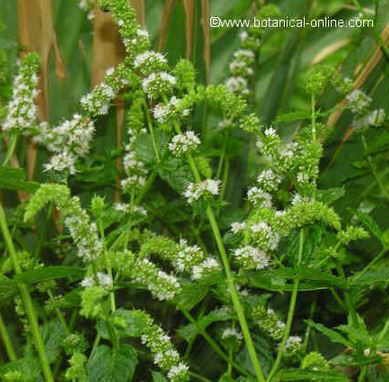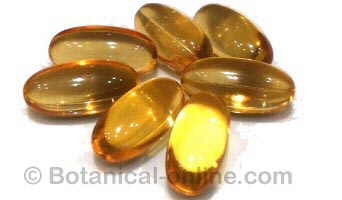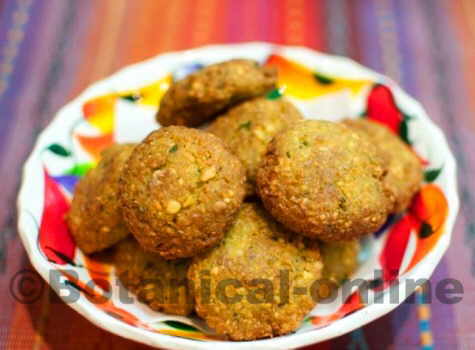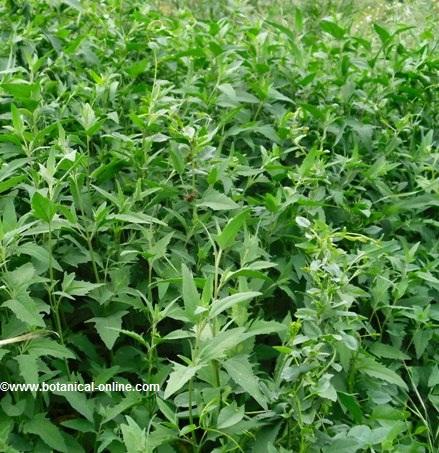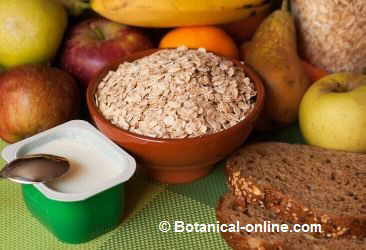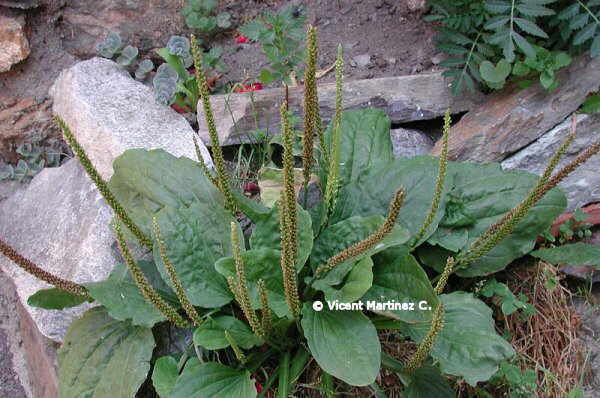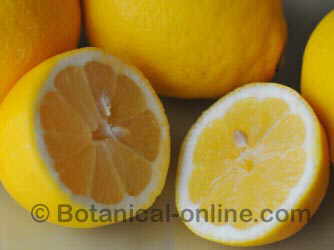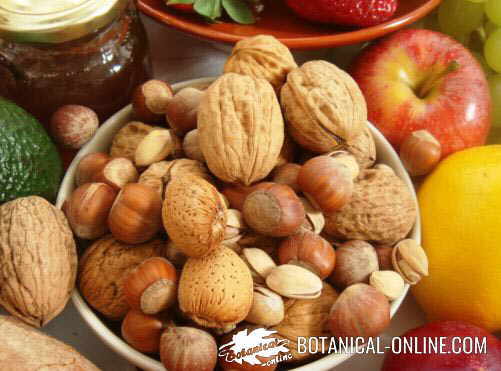Contents
What is a mullein plant?
Mullein characteristics (Verbascum thapsus)
Common English name: mullein, common mullein, great mullein, flannelleaf, flannelplant, beggar’s blanket, velvetplant, bullock’s lungwort, Aaron’s rod, hedge-taper, king’s taper, shepherd’s staff, candlewick plant, torch plant.
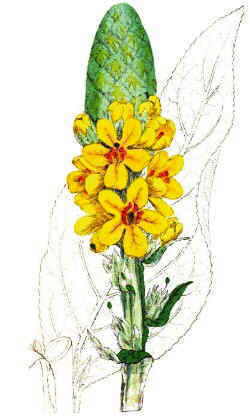 In the image: illustration of the inflorescence of the mullein, with open flowers and basal leaf (background).
In the image: illustration of the inflorescence of the mullein, with open flowers and basal leaf (background).Scientific name: Verbascum thapsus L.
Etymology: the term Verbascum derives from the Latin Barbascum, which means “beard”. This denomination refers to the dense pilosity of the leaves of this plant.
Family: Scrophulariaceae
Origin: Eurosiberian
Habitat: uncultivated lands of Europe and Western Asia, embankments, fallows, stony soils, wastelands, forests and prairies. Cultivated in many places of the world as a garden plant.
Distribution: Roman legions took this plant to England, and, from there, it was introduced into the colonies of America as a garden plant.
Mullein can be found by all the temperate zones of Europe until tropical Asia. It has become a feral species in North Africa and North America.
Characteristics of common mullein
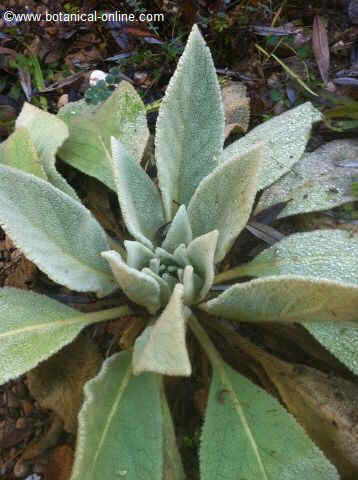 In the image: mullein plant during the first year of growth, when only its basal leaves are formed.
In the image: mullein plant during the first year of growth, when only its basal leaves are formed.Common mullein (Verbascum thapsus) is a biennial and robust growth plant. Mullein is one of the oldest medicinal plants in the world, mainly used in pectoral tisanes. Currently, this plant is cultivated in gardens and grows wild in prairies and wastelands
Although it is notable for its large size, the truth is that the first year, mullein only forms a basal rosette, a little more than 60cm. height.
During the second year of growth, the plant develops its characteristic floral stem and can reach 2 meters in height.
Its stem is erect, sometimes branched, and has a dense hairiness that covers it.
Its leaves are alternate, simple and petiolate. The limb is oval, grooved and the whole leaf is hairy. The dense pubescence that covers the whole plant is useful to retain moisture as well as repel predators and insects. Leaves have discreetly jagged margins.
Basal leaves are larger and more numerous, between 10-20 cm. Long by 4-8cm. Wide. As the plant grows, its upper leaves are smaller in size.
The form in which the leaves are arranged deserve special mention. The hairy leaves are oriented alternately, so that the upper leaves collect the water from the rain and channel it towards the lower leaves, which will carry that water to the roots.
The floral stem, which develops in the second year of plant growth, is long and with terminal inflorescence.
The inflorescence is formed by a glomerulus with numerous yellow flowers with rotaceous corolla of five unequal petals.
Mullein flowers between June and August. It is a melliferous plant, that is to say, bees produce honey from its flowers.
The fruit is a globulous ovoid capsule, with two valves containing numerous seeds.
Tiny seeds, 0.5-1mm. Long.
Used parts of mullein
- Leaves and flowers.
- The flowers must be collected in the morning, between June and September. The corolla is collected without the calyx, very delicately so as not to damage the petals, and must be dried in the shade. The dried flowers have a lighter yellow hue, and, if they are chewed, they have a mucilaginous texture.
- Leaves are used externally as medicinal. they are NOT edible.
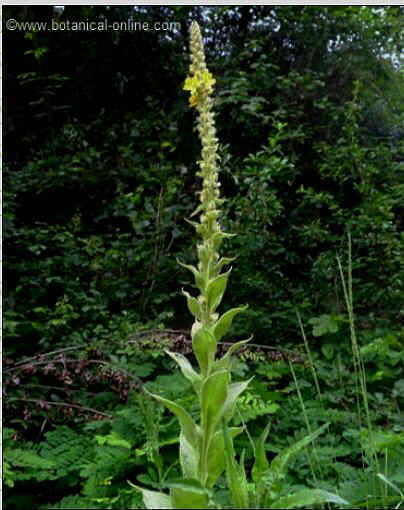 Mullein plant with flowers. Mullein plant with flowers. | 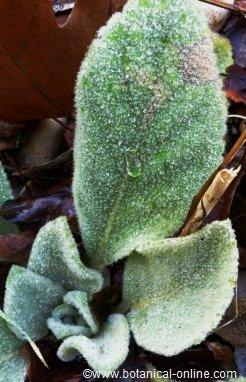 Mullein leaf Mullein leaf |
Uses of mullein
- Phytotherapy: Mullein is considered a plant for the respiratory system. In its traditional use, it has been used to soften the bronchi and all the tissues of the body thanks to its mucilaginous fiber. It is also used to cure wounds
- * More information on the medicinal properties of mullein.
- Liquor: the flowers serve to flavor liquors.
- Home cosmetics: the flowers have a yellow coloring substance, which Roman women used by means of infusion to give their hair a golden color.
Other preparations with mullein
– Mullein, a magic plant: in the Middle Ages, it was believed that mullein possessed properties against the spells, and it is said that the magicians used the stems of this plant as candles, to perform their enchantments.
In the Middle Ages it received the name of ” lamp herb” (herba luminaria), and the leaves and stems, impregnated with wax or fish oil, were used as wicks of candles and torches. The dry plant is an excellent tinder to ignite the fire.
Mullein leaves have been used as thermal insulation, placed at the base of the shoes, to keep the foot warm.
Its velvety softness has turned it into a historic wild toilet paper – in English it is known as “cowboy toilet paper”.
– Verbascum thapsus to catch fish: The plant was formerly used to stupefy the waters so as to catch fish. In Spanish language, this action is defined as “embarbascar” a word that means “to poison the water with verbascum or a similar substance to stan the fish”.
This method was already used by the ancient Romans, who knew of their properties and used its ripe fruits crushed, with the seeds, or its fresh juice from the leaves to fish. In fact, the plant is rich in iridoid glycosides, which are toxic to fish. Intoxicated fish are easily caught.
From this property derives its Castilian name “matapeces” (= fish killer).
Active components of mullein
The whole plant is rich in iridoid glycosides: iridoids are the active principles of the plant, and are present in flowers and leaves.
- Aucuboside or aucubin, responsible for the blackening of the plant once collected, also present in plantain. It has antibacterial, antiinflammatory, cathartic and diuretic properties.
- Verbacoside or acteoside, a substance with antibacterial, antifungal, analgesic and antihypertensive activity. Chemically it is an osidic derivative of caffeic acid, along with the pilumoside, another component of the plant.
- Harpagide and harpagoside, active antiinflammatory principles similar to those found in Devil’s Claw (Harpagophytum procumbens).
- Catalpol, a substance also present in plantain, with laxative, diuretic and purgative properties. It also contains isocatalpol and 6Bxylosilcatalpol.
- Mucilage (3%): leaves are the part of the plant richer in mucilage fiber, so they are often used as emollient and demulcent plasters (softening and antipruginous properties).
- Triterpene saponins (verbascosaponins): toxic principles present in seeds and, to a lesser extent, in leaves. Saponins have a mucolytic effect and are used in the treatment of cough.
- Phytosterols: verbasterol (flowers), betasitosterol (seeds)
- Flavonoids: hesperidin glucosides, hesperidin, verbascin, rutin. Carotenoids: crocetin (yellow pigment also present in saffron), xanthophyll, betacarotenes.
- Thapsicacid
- Coumarins
- Minerals: potassium, calcium, magnesium, iron, sodium, cobalt, manganese, phosphorus, aluminum, chromium, selenium, zinc, tin.
- Vitamins: vitamin C, thiamin, niacin
- At the root there is rotenone, toxic principle: the root is not medicinal or edible. Rotenones (heptaose, nonaose, octaose) are insecticidal, pesticidal and larvicidal substances.
| Botanical classification | |
| Kingdom | Plantae – Plants |
| Subkingdom | Tracheobionta Vascular plants |
| Superdivision | Spermatophyta Seed plants |
| Division | Magnoliophyta Flower plants |
| Class | Magnoliopsida Dicotyledonous |
| Subclass | Asteridae |
| Order | Lamiales |
| Family | Scrophulariaceae |
| Gender | Verbascum |
| Species | V. thapsus |
![]() More information on mullein.
More information on mullein.

